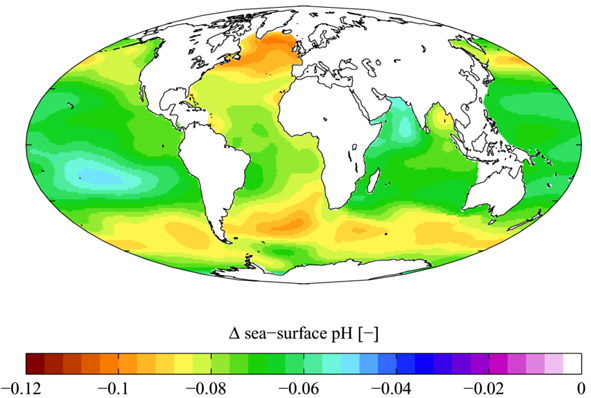
Change in sea surface pH caused by anthropogenic CO2 emissions between the 1700s and 1990s.
Posted on 02/07/2009 8:42:10 PM PST by Delacon
So in the tropics where ocean acidification is hypothesized as the cause of coral reef degradation is not the effect of atmospheric CO2 due to human activity. That ocean water is releasing CO2 absorbed ages ago. It shifts your equation to the left. The surface waters in the tropics release CO2.
CO2 + H2O <----> H2CO3 (carbonic acid) <----> H+ + HCO3-

Change in sea surface pH caused by anthropogenic CO2 emissions between the 1700s and 1990s.
I witnessed my first anti-warming agenda commercial tonite on FNC. It was informative and smacked Algore pretty good.
19th century average atmospheric CO2 never got higher than 300 ppm.

Current value is 384.
Recent Greenhouse Gas Concentrations
[(384-280)/280] x 100 = 37.1%. Sorry for rounding up.
The link in comment# 37 says that CO2 was absorbed by the oceans 1000 years ago. So whatever is ailing the coral reefs, it isn't AGW. CO2 is also released from natural fires and volcanic emissions, not just human activity.
Actually more like 500, but still...
There's two things going on at the same time. Deep ocean waters are more acidic than shallow waters because of the combined processes of CO2 dissolution and bacterial organic matter respiration in deep water. These deep waters "surface" primarily in the North Pacific, thought there's some leakage in the Antarctic and Indian Ocean, about 500 years after they first sank. That's the solubility or carbon pump the link speaks of.
There isn't significant upwelling of the deep abyssal water in the equatorial Pacific.
So... with increased atmospheric CO2, there's an increased pCO2 in the atmosphere -- everywhere. You get surface water absorption in the cold windy waters. Surface (wind-driven) currents move this water elsewhere. With increased pCO2 in the atmosphere, there's also a reduction of the surface flux into the atmosphere from the warm calm waters, which are also receiving a contribution of the surface waters that have absorbed more CO2 in the cold windy regions (circulated by those same surface wind-driven currents). And that's why there's an acidification process going on everywhere, most prominently where the CO2 is being absorbed, less prominently where it's being released.
But the thing is, what you said is right: "So whatever is ailing the coral reefs, it isn't AGW." Right now, acidification is a very minor player; it's actually affecting calcaerous organisms in the deep benthos, but not coral reefs. Coral reefs are being messed up by coastal pollution (including raw sewage), eutrophication, overfishing, increased atmospheric transport of disease organisms, and warmer surface waters. Their future is bleak. Progressive acidification will make an already bad situation worse. If anything serious could be done about all the other problems affecting coral reefs, progressive acidification will just basically make it harder for them to recover.
Not So Fun in the Sun
How Solar Activity Affects Temperatures on Earth
If CO2 didn’t cause the warming we experienced through the 1990s, what did cause it? In 1801 astronomer William Herschel, discoverer of the planet Uranus and of infrared radiation, is said to have predicted the price of grain from counting the number of observable sunspots. When the sunspots increased, the weather warmed and the price of grain came down. During periods of low activity, the weather cooled, crops diminished, and the price rose. The relationship between solar activity and temperature has been noted for years, but the increase in solar irradiance can be shown to be too small to account for significant changes in temperature. However, the correlation was far too close to be coincidental and is a far better correlation to Earth’s temperature record than CO2 as a climate forcing agent. It seems we were looking in the wrong direction. In 2004, Nir Shaviv and Jan Vetzer of the Hebrew University showed empirical evidence that “cosmic ray flux” had an impact on climate variability.
Though increases and decreases in solar irradiance wouldn’t directly produce Earth’s measured temperature changes, solar activity appears to have an indirect effect. A supernova sends out swarms of cosmic rays (mostly protons and electrons) that cause small particles in our atmosphere to attract one another, becoming nuclei for cloud formations high in the atmosphere. During periods of high solar activity, solar winds and magnetic fields act to block these cosmic intruders and prevent the formation of clouds. As high clouds reflect sunlight, preventing their formation increases the radiation reaching the surface and increases the global temperature. In other words, high solar activity, evidenced by sunspots, disrupts cloud formation, thus allowing more solar heating of the Earth.
The ‘90s were a period of high solar activity, but this has slowed down. In fact, it has virtually stopped. The total solar irradiance, as reported by NASA’s David Hathaway, is at the lowest point on record — although the record is only a few decades long. Furthermore, sunspots migrate across the sun as the sunspot (solar) cycle matures. Usually a new sunspot cycle would have already been active by this time — but it hasn’t started. This is very bad news for the global-warming alarmists, as the data show this is the precursor of a cooling trend. Actually, it is not such good news for skeptics either, as colder weather is much more dangerous and uncomfortable than warmer weather for many reasons. Personally, I’m not a big fan of driving a team of horses across a frozen Arkansas River.
Disclaimer: Opinions posted on Free Republic are those of the individual posters and do not necessarily represent the opinion of Free Republic or its management. All materials posted herein are protected by copyright law and the exemption for fair use of copyrighted works.